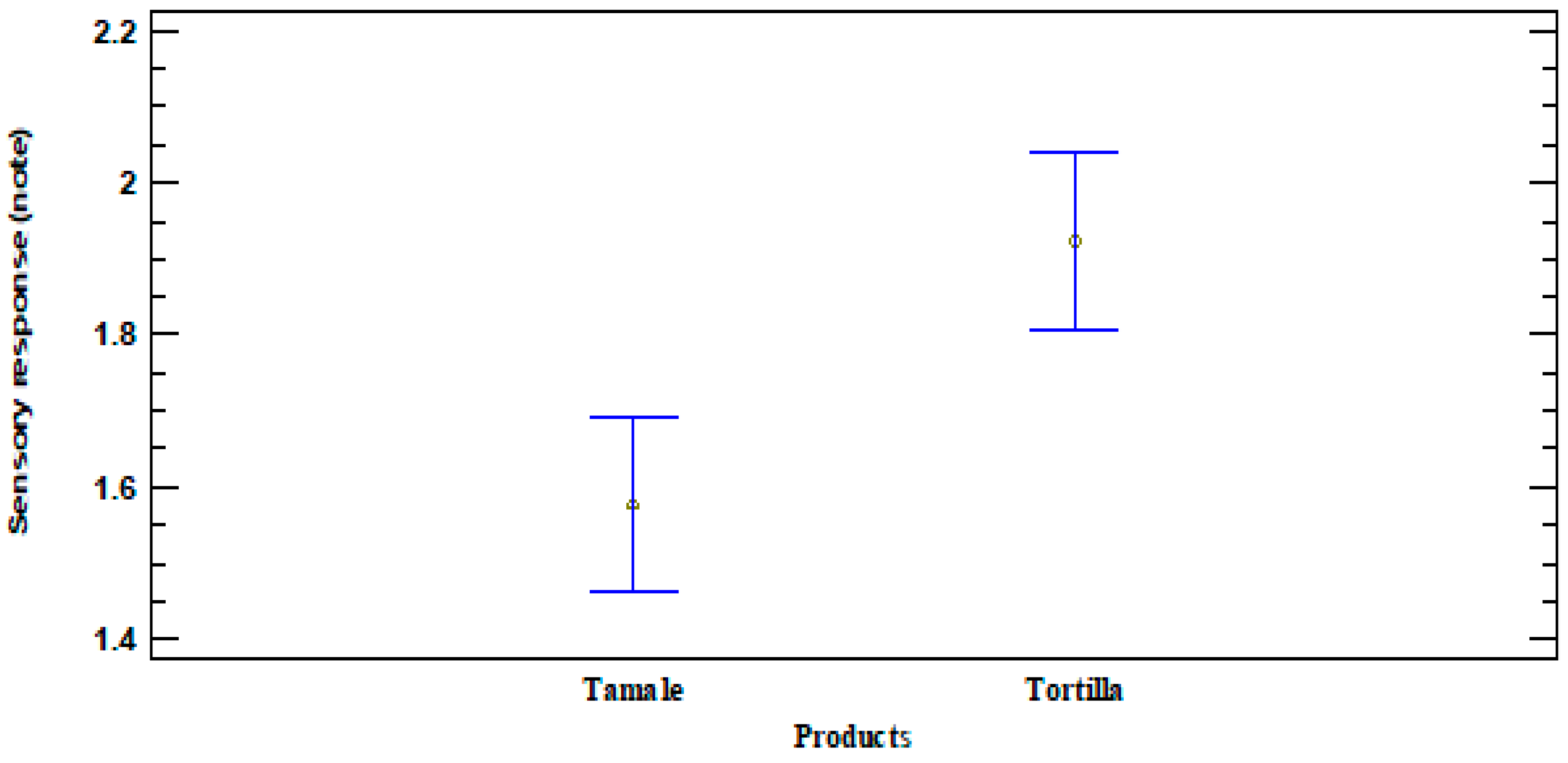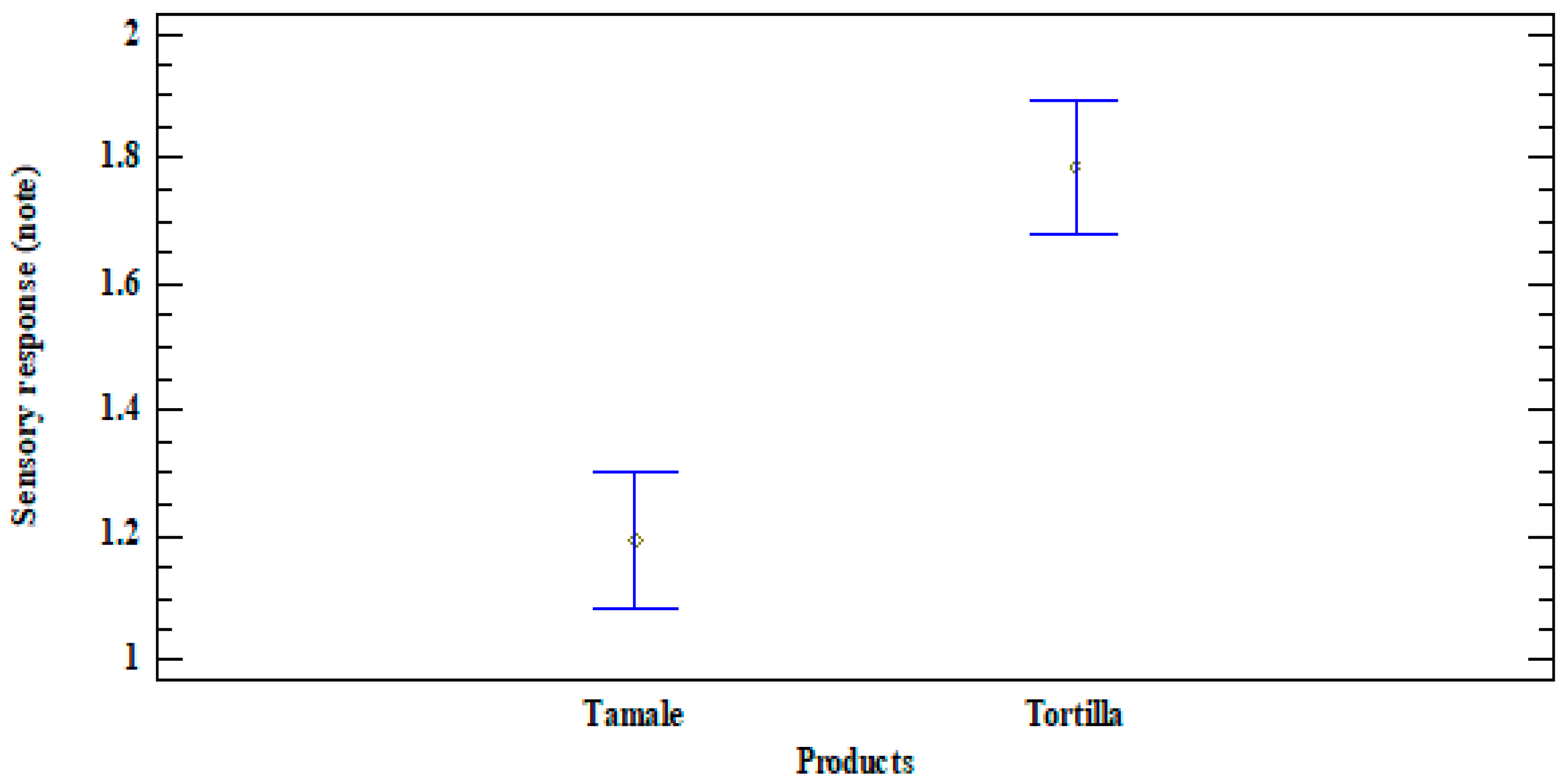Acceptability of Tortillas and Tamales Made with Nixtamalized Corn with Germinated Chia Flour †
Abstract
1. Introduction
2. Materials and Methods
2.1. Seeds and Corn Flour
2.2. Germination
2.3. Preparation of Germinated Chia Flour
2.4. Preparation of Germinated Chia Flour
2.4.1. Tortillas
2.4.2. Tamales
2.5. Selection of Judges for Sensory Analysis
2.6. Sensory Analysis
2.7. Statistical Analysis
3. Results
4. Discussion
5. Conclusions
Author Contributions
Funding
Institutional Review Board Statement
Informed Consent Statement
Data Availability Statement
Acknowledgments
Conflicts of Interest
References
- El Maíz En La Nutrición Humana; FAO: Rome, Italy, 1993; Available online: https://www.fao.org/4/t0395s/T0395S00.htm#Contents (accessed on 17 April 2024).
- Chávez, O.F. Situación del cultivo de maíz en Guatemala: Principales limitaciones en la productividad. ACI Av. Cienc. Ing. 2022, 14, 1–12. [Google Scholar] [CrossRef]
- Rodríguez-Huezo, M.E.; Flores-Silva, P.C.; Garcia-Diaz, S.; Meraz, M.; Vernon-Carter, E.J.; Alvarez-Ramirez, J. Effect of fat type on starch and protein digestibility of traditional tamales. Die Starke 2018, 70, 1700286. [Google Scholar] [CrossRef]
- Ruiz Vásquez, D.A.; Soriano Colchado, J.L. Efecto de proporción de pasta de cacao (Theobroma Cacao L.) y harina de plátano (musa paradisiaca aab) en la aceptabilidad general de una mezcla alimenticia. Cientifi-k 2014, 2, 33–43. [Google Scholar]
- Salgado, V.d.S.C.N.; Zago, L.; Antunes, A.E.C.; Miyahira, R.F. Chia (Salvia hispanica L.) Seed Germination: A Brief Review. Plant Foods Hum. Nutr. 2022, 77, 485–494. [Google Scholar] [CrossRef] [PubMed]
- Argüelles-López, O.D.; Reyes-Moreno, C.; Gutiérrez-Dorado, R.; Sánchez-Osuna, M.F.; López-Cervantes, J.; Cuevas-Rodríguez, E.O.; Milán-Carrillo, J.; Perales-Sánchez, J.X.K. Functional beverages elaborated from amaranth and chia flours processed by germination and extrusion. Biotecnia 2018, 20, 135–145. Available online: https://biotecnia.unison.mx/index.php/biotecnia/article/view/721/289 (accessed on 28 April 2024). [CrossRef]
- Katunzi-Kilewela, A.; Kaale, L.D.; Kibazohi, O.; Rweyemamu, L.M. Nutritional, health benefits and usage of chia seeds (Salvia hispanica): A review. Afr. J. Food Sci. 2021, 15, 48–59. [Google Scholar] [CrossRef]
- Rendón-Villalobos, R.; Ortíz-Sánchez, A.; Solorza-Feria, J.; Trujillo-Hernández, C.A. Formulation, Physicochemical, Nutritional and Sensorial Evaluation of Corn Tortillas Supplemented with Chía Seed (Salvia hispanica L.). Czech J. Food Sci. 2012, 30, 118. [Google Scholar] [CrossRef]
- Liu, T.; Hou, G.G.; Cardin, M.; Marquart, L.; Dubat, A. Quality attributes of whole-wheat flour tortillas with sprouted whole-wheat flour substitution. Lebensm. -Wiss. Und Technol. [Food Sci. Technol.] 2017, 77, 1–7. [Google Scholar] [CrossRef]
- Ghafoor, K.; Al Juhaimi, F.; Özcan, M.M.; Uslu, N.; Ahmed, I.A.M.; Babiker, E.E. The effect of boiling, germination and roasting on bioactive properties, phenolic compounds, fatty acids and minerals of chia seed (Salvia hispanica L.) and oils. Int. J. Gastron. Food Sci. 2022, 27, 100447. [Google Scholar] [CrossRef]
- Rodríguez Paucar, G.N.; Aguirre Vargas, E.B.; Villanueva Lopez, E.; León Lopez, A.; Urbina Castillo, K. Incorporation of chia seeds (Salvia hispanica L.) in cereal flour mixtures: Rheology and quality of sliced bread. Dyna 2021, 88, 109–116. [Google Scholar] [CrossRef]
- Valenzuela, B.A.; Sanhueza, C.J.; Nieto, K.S. ¿es posible mejorar la calidad nutricional DE Los aceites comestibles. Rev. Chil. Nutr. Órgano Of. La Soc. Chil. Nutr. Bromatol. Toxicol. 2002, 29, 174–180. [Google Scholar] [CrossRef]


| Appearance Attribute | ||
|---|---|---|
| Product | Tortilla | Tamale |
| Formulation | 90:10 | 90:10 |
| Mean ± SD | 1.92 ± 0.82 a | 1.58 ± 0.60 b |
| Sum of squares | 3.11 | |
| Gl | 1 | |
| Mean square | 3.12 | |
| F-ratio | 8.88 | |
| p | 0.0044 | |
| Texture Attribute | ||
| Product | Tortilla | Tamale |
| Formulation | 90:10 | 90:10 |
| Mean (SD) | 1.79 ± 0.68 a | 1.19 ± 0.16 b |
| Sum of squares | 9.24038 | |
| Gl | 1 | |
| Mean square | 9.24 | |
| F-ratio | 30.88 | |
| p | 1.00 × 10−6 | |
Disclaimer/Publisher’s Note: The statements, opinions and data contained in all publications are solely those of the individual author(s) and contributor(s) and not of MDPI and/or the editor(s). MDPI and/or the editor(s) disclaim responsibility for any injury to people or property resulting from any ideas, methods, instructions or products referred to in the content. |
© 2024 by the authors. Licensee MDPI, Basel, Switzerland. This article is an open access article distributed under the terms and conditions of the Creative Commons Attribution (CC BY) license (https://creativecommons.org/licenses/by/4.0/).
Share and Cite
Cota, M.E.; Salazar, E.J. Acceptability of Tortillas and Tamales Made with Nixtamalized Corn with Germinated Chia Flour. Biol. Life Sci. Forum 2024, 37, 16. https://doi.org/10.3390/blsf2024037016
Cota ME, Salazar EJ. Acceptability of Tortillas and Tamales Made with Nixtamalized Corn with Germinated Chia Flour. Biology and Life Sciences Forum. 2024; 37(1):16. https://doi.org/10.3390/blsf2024037016
Chicago/Turabian StyleCota, María Eunice, and Elsa Julieta Salazar. 2024. "Acceptability of Tortillas and Tamales Made with Nixtamalized Corn with Germinated Chia Flour" Biology and Life Sciences Forum 37, no. 1: 16. https://doi.org/10.3390/blsf2024037016
APA StyleCota, M. E., & Salazar, E. J. (2024). Acceptability of Tortillas and Tamales Made with Nixtamalized Corn with Germinated Chia Flour. Biology and Life Sciences Forum, 37(1), 16. https://doi.org/10.3390/blsf2024037016





